Economic Report: Correcting High Inflation Rates in Vermoulli
VerifiedAdded on 2022/09/18
|6
|1032
|24
Report
AI Summary
This report, prepared for the Ministry of Financial Affairs of Vermoulli, addresses the issue of high inflation rates. It explores two primary techniques: fiscal and monetary policy, detailing their differences and components. The report explains expansionary and contractionary fiscal policies, including the use of expenditure multipliers, transfer payments, and tax multipliers. It also covers expansionary and contractionary monetary policies, discussing overnight interest rates, bank rates, money multipliers, and open market operations. The analysis concludes that contractionary monetary and fiscal policies are the most effective solutions. The report also acknowledges the limitations of both policies, such as difficulties in predicting the economy's future and the potential failure of low-interest rates. References are provided in APA format.
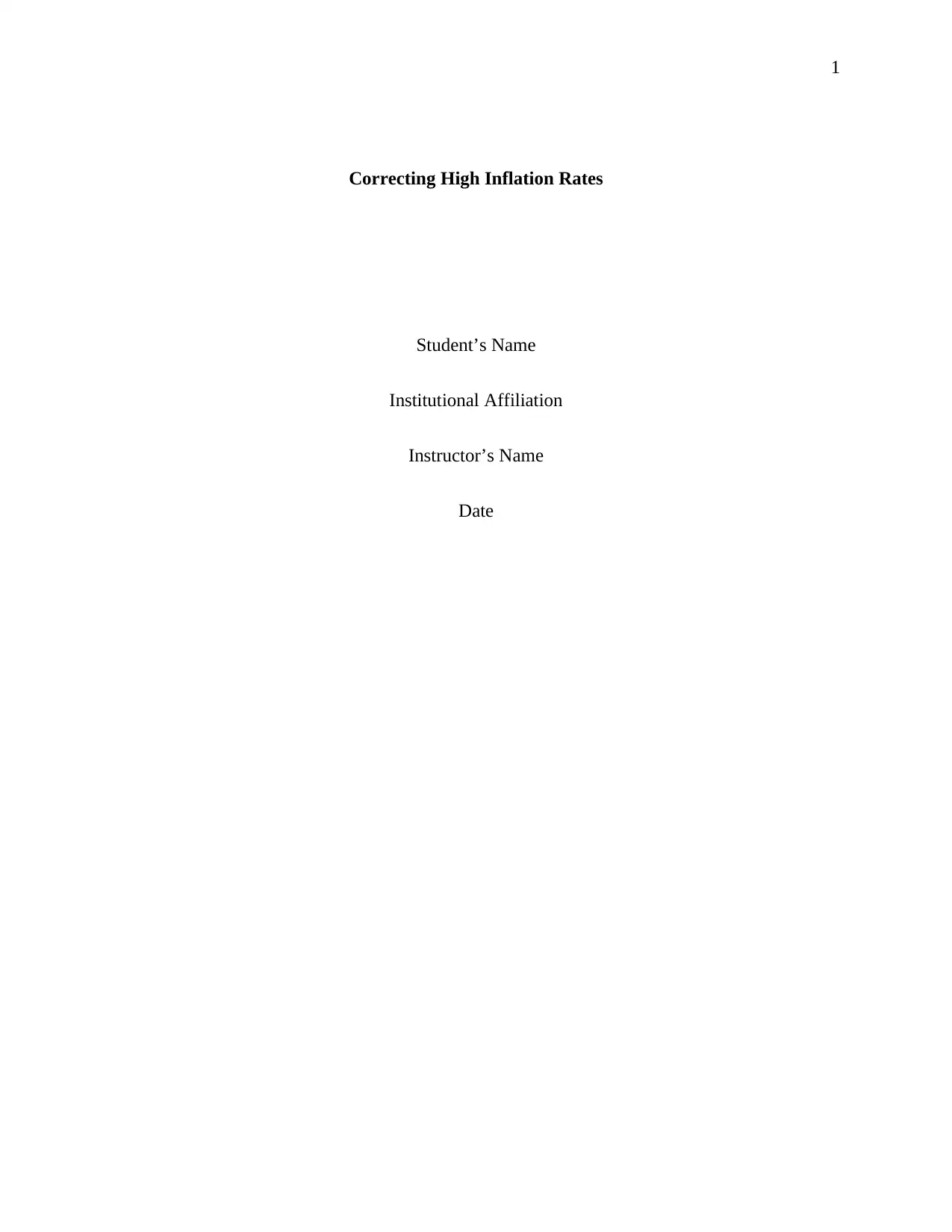
1
Correcting High Inflation Rates
Student’s Name
Institutional Affiliation
Instructor’s Name
Date
Correcting High Inflation Rates
Student’s Name
Institutional Affiliation
Instructor’s Name
Date
Paraphrase This Document
Need a fresh take? Get an instant paraphrase of this document with our AI Paraphraser
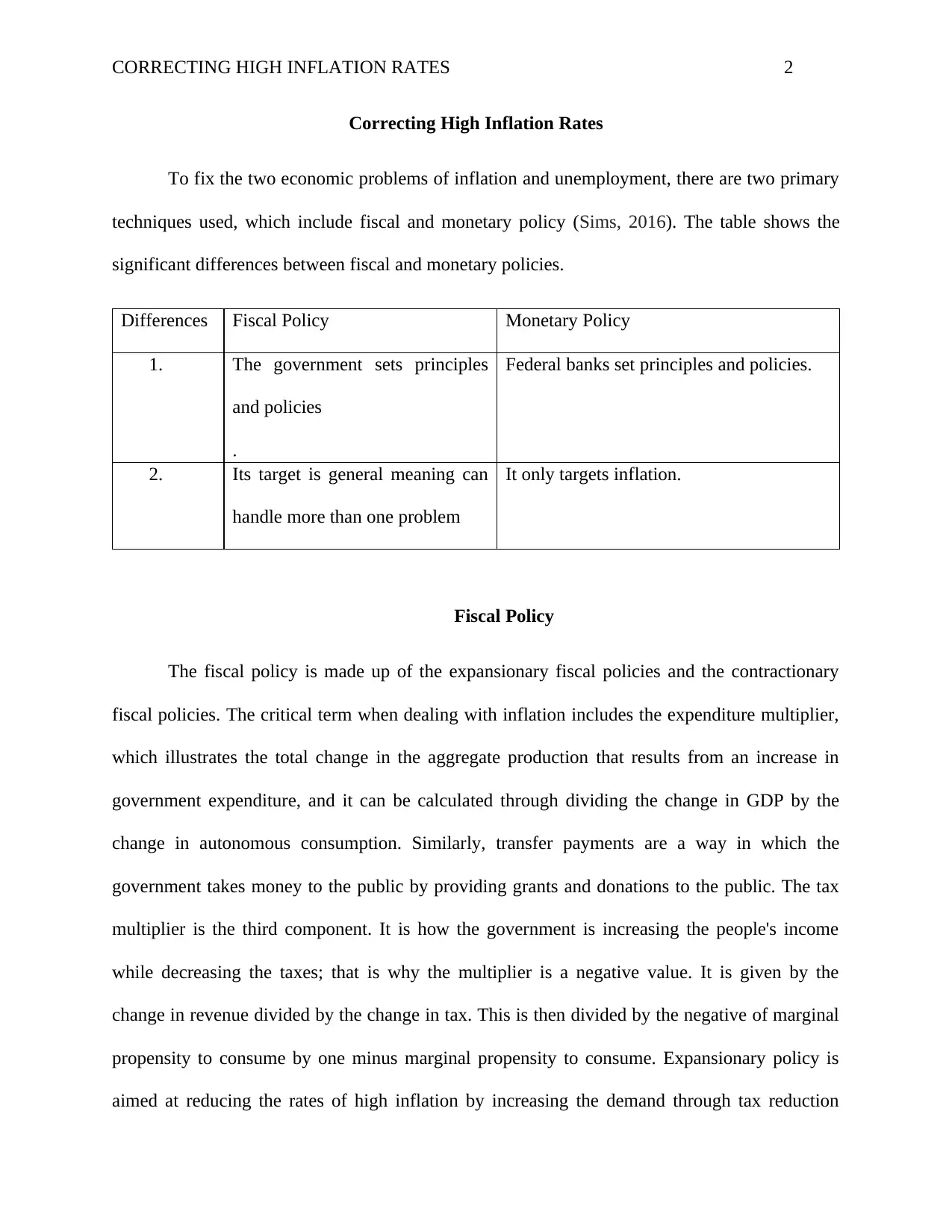
CORRECTING HIGH INFLATION RATES 2
Correcting High Inflation Rates
To fix the two economic problems of inflation and unemployment, there are two primary
techniques used, which include fiscal and monetary policy (Sims, 2016). The table shows the
significant differences between fiscal and monetary policies.
Differences Fiscal Policy Monetary Policy
1. The government sets principles
and policies
.
Federal banks set principles and policies.
2. Its target is general meaning can
handle more than one problem
It only targets inflation.
Fiscal Policy
The fiscal policy is made up of the expansionary fiscal policies and the contractionary
fiscal policies. The critical term when dealing with inflation includes the expenditure multiplier,
which illustrates the total change in the aggregate production that results from an increase in
government expenditure, and it can be calculated through dividing the change in GDP by the
change in autonomous consumption. Similarly, transfer payments are a way in which the
government takes money to the public by providing grants and donations to the public. The tax
multiplier is the third component. It is how the government is increasing the people's income
while decreasing the taxes; that is why the multiplier is a negative value. It is given by the
change in revenue divided by the change in tax. This is then divided by the negative of marginal
propensity to consume by one minus marginal propensity to consume. Expansionary policy is
aimed at reducing the rates of high inflation by increasing the demand through tax reduction
Correcting High Inflation Rates
To fix the two economic problems of inflation and unemployment, there are two primary
techniques used, which include fiscal and monetary policy (Sims, 2016). The table shows the
significant differences between fiscal and monetary policies.
Differences Fiscal Policy Monetary Policy
1. The government sets principles
and policies
.
Federal banks set principles and policies.
2. Its target is general meaning can
handle more than one problem
It only targets inflation.
Fiscal Policy
The fiscal policy is made up of the expansionary fiscal policies and the contractionary
fiscal policies. The critical term when dealing with inflation includes the expenditure multiplier,
which illustrates the total change in the aggregate production that results from an increase in
government expenditure, and it can be calculated through dividing the change in GDP by the
change in autonomous consumption. Similarly, transfer payments are a way in which the
government takes money to the public by providing grants and donations to the public. The tax
multiplier is the third component. It is how the government is increasing the people's income
while decreasing the taxes; that is why the multiplier is a negative value. It is given by the
change in revenue divided by the change in tax. This is then divided by the negative of marginal
propensity to consume by one minus marginal propensity to consume. Expansionary policy is
aimed at reducing the rates of high inflation by increasing the demand through tax reduction
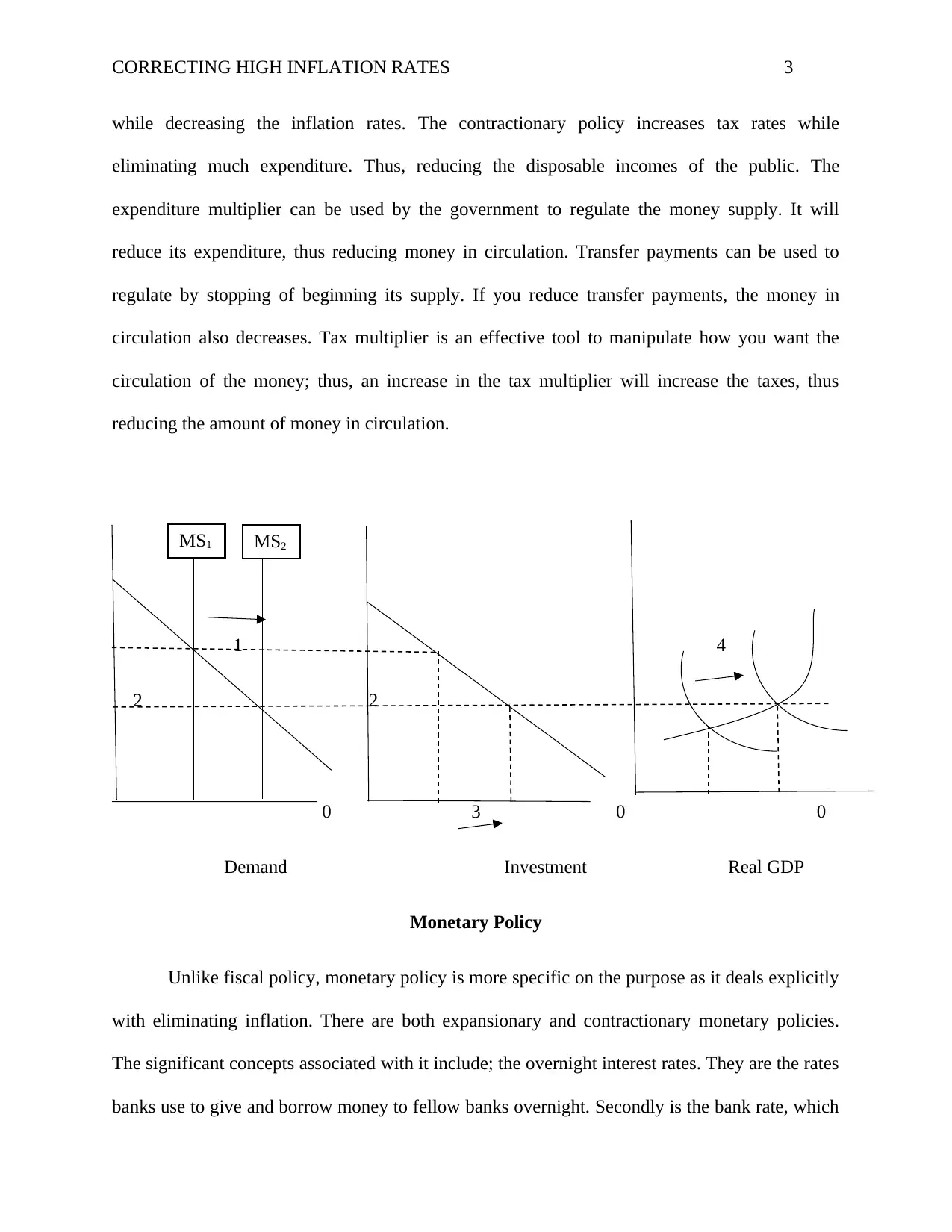
CORRECTING HIGH INFLATION RATES 3
while decreasing the inflation rates. The contractionary policy increases tax rates while
eliminating much expenditure. Thus, reducing the disposable incomes of the public. The
expenditure multiplier can be used by the government to regulate the money supply. It will
reduce its expenditure, thus reducing money in circulation. Transfer payments can be used to
regulate by stopping of beginning its supply. If you reduce transfer payments, the money in
circulation also decreases. Tax multiplier is an effective tool to manipulate how you want the
circulation of the money; thus, an increase in the tax multiplier will increase the taxes, thus
reducing the amount of money in circulation.
1 4
2 2
0 3 0 0
Demand Investment Real GDP
Monetary Policy
Unlike fiscal policy, monetary policy is more specific on the purpose as it deals explicitly
with eliminating inflation. There are both expansionary and contractionary monetary policies.
The significant concepts associated with it include; the overnight interest rates. They are the rates
banks use to give and borrow money to fellow banks overnight. Secondly is the bank rate, which
MS1 MS2
while decreasing the inflation rates. The contractionary policy increases tax rates while
eliminating much expenditure. Thus, reducing the disposable incomes of the public. The
expenditure multiplier can be used by the government to regulate the money supply. It will
reduce its expenditure, thus reducing money in circulation. Transfer payments can be used to
regulate by stopping of beginning its supply. If you reduce transfer payments, the money in
circulation also decreases. Tax multiplier is an effective tool to manipulate how you want the
circulation of the money; thus, an increase in the tax multiplier will increase the taxes, thus
reducing the amount of money in circulation.
1 4
2 2
0 3 0 0
Demand Investment Real GDP
Monetary Policy
Unlike fiscal policy, monetary policy is more specific on the purpose as it deals explicitly
with eliminating inflation. There are both expansionary and contractionary monetary policies.
The significant concepts associated with it include; the overnight interest rates. They are the rates
banks use to give and borrow money to fellow banks overnight. Secondly is the bank rate, which
MS1 MS2
⊘ This is a preview!⊘
Do you want full access?
Subscribe today to unlock all pages.

Trusted by 1+ million students worldwide
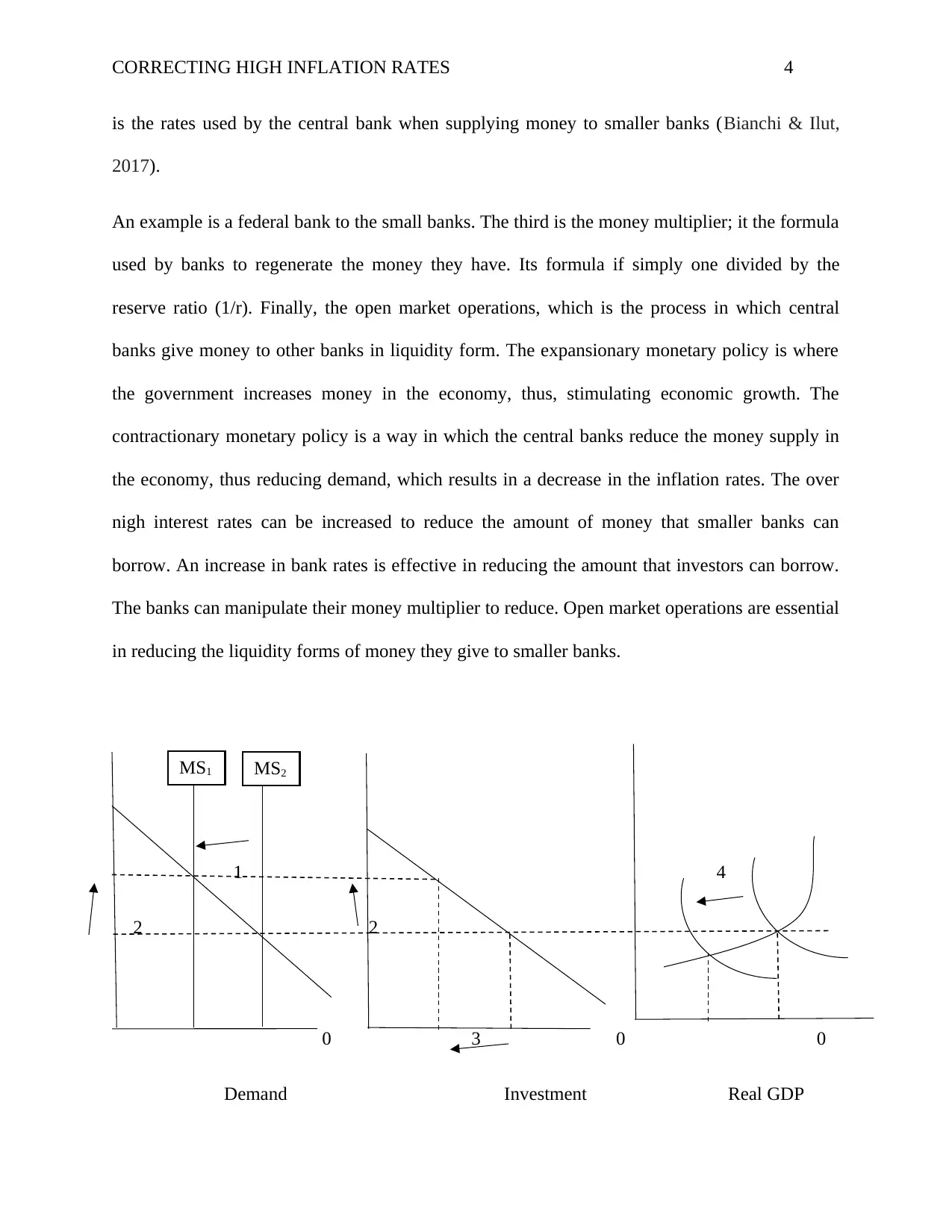
CORRECTING HIGH INFLATION RATES 4
is the rates used by the central bank when supplying money to smaller banks (Bianchi & Ilut,
2017).
An example is a federal bank to the small banks. The third is the money multiplier; it the formula
used by banks to regenerate the money they have. Its formula if simply one divided by the
reserve ratio (1/r). Finally, the open market operations, which is the process in which central
banks give money to other banks in liquidity form. The expansionary monetary policy is where
the government increases money in the economy, thus, stimulating economic growth. The
contractionary monetary policy is a way in which the central banks reduce the money supply in
the economy, thus reducing demand, which results in a decrease in the inflation rates. The over
nigh interest rates can be increased to reduce the amount of money that smaller banks can
borrow. An increase in bank rates is effective in reducing the amount that investors can borrow.
The banks can manipulate their money multiplier to reduce. Open market operations are essential
in reducing the liquidity forms of money they give to smaller banks.
1 4
2 2
0 3 0 0
Demand Investment Real GDP
MS1 MS2
is the rates used by the central bank when supplying money to smaller banks (Bianchi & Ilut,
2017).
An example is a federal bank to the small banks. The third is the money multiplier; it the formula
used by banks to regenerate the money they have. Its formula if simply one divided by the
reserve ratio (1/r). Finally, the open market operations, which is the process in which central
banks give money to other banks in liquidity form. The expansionary monetary policy is where
the government increases money in the economy, thus, stimulating economic growth. The
contractionary monetary policy is a way in which the central banks reduce the money supply in
the economy, thus reducing demand, which results in a decrease in the inflation rates. The over
nigh interest rates can be increased to reduce the amount of money that smaller banks can
borrow. An increase in bank rates is effective in reducing the amount that investors can borrow.
The banks can manipulate their money multiplier to reduce. Open market operations are essential
in reducing the liquidity forms of money they give to smaller banks.
1 4
2 2
0 3 0 0
Demand Investment Real GDP
MS1 MS2
Paraphrase This Document
Need a fresh take? Get an instant paraphrase of this document with our AI Paraphraser
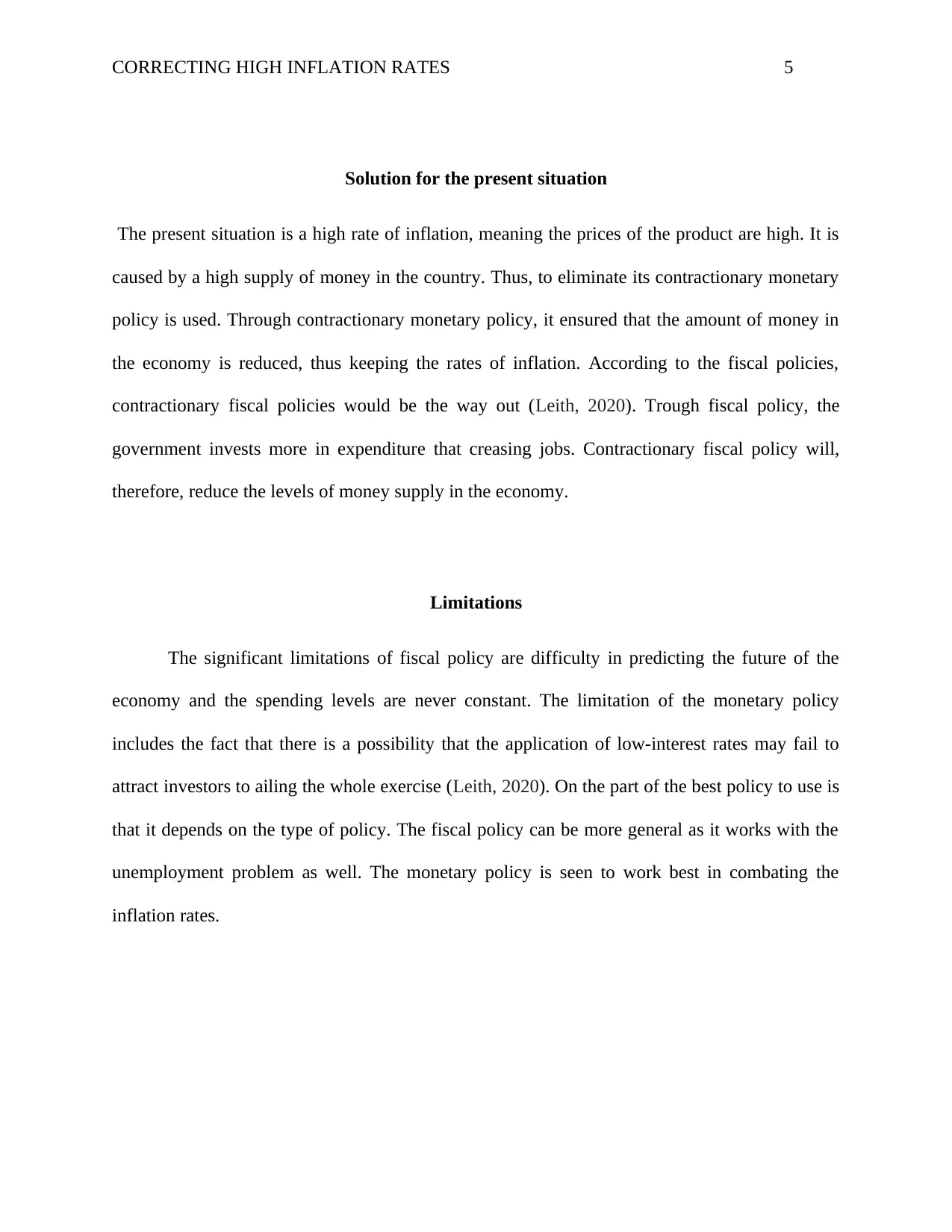
CORRECTING HIGH INFLATION RATES 5
Solution for the present situation
The present situation is a high rate of inflation, meaning the prices of the product are high. It is
caused by a high supply of money in the country. Thus, to eliminate its contractionary monetary
policy is used. Through contractionary monetary policy, it ensured that the amount of money in
the economy is reduced, thus keeping the rates of inflation. According to the fiscal policies,
contractionary fiscal policies would be the way out (Leith, 2020). Trough fiscal policy, the
government invests more in expenditure that creasing jobs. Contractionary fiscal policy will,
therefore, reduce the levels of money supply in the economy.
Limitations
The significant limitations of fiscal policy are difficulty in predicting the future of the
economy and the spending levels are never constant. The limitation of the monetary policy
includes the fact that there is a possibility that the application of low-interest rates may fail to
attract investors to ailing the whole exercise (Leith, 2020). On the part of the best policy to use is
that it depends on the type of policy. The fiscal policy can be more general as it works with the
unemployment problem as well. The monetary policy is seen to work best in combating the
inflation rates.
Solution for the present situation
The present situation is a high rate of inflation, meaning the prices of the product are high. It is
caused by a high supply of money in the country. Thus, to eliminate its contractionary monetary
policy is used. Through contractionary monetary policy, it ensured that the amount of money in
the economy is reduced, thus keeping the rates of inflation. According to the fiscal policies,
contractionary fiscal policies would be the way out (Leith, 2020). Trough fiscal policy, the
government invests more in expenditure that creasing jobs. Contractionary fiscal policy will,
therefore, reduce the levels of money supply in the economy.
Limitations
The significant limitations of fiscal policy are difficulty in predicting the future of the
economy and the spending levels are never constant. The limitation of the monetary policy
includes the fact that there is a possibility that the application of low-interest rates may fail to
attract investors to ailing the whole exercise (Leith, 2020). On the part of the best policy to use is
that it depends on the type of policy. The fiscal policy can be more general as it works with the
unemployment problem as well. The monetary policy is seen to work best in combating the
inflation rates.
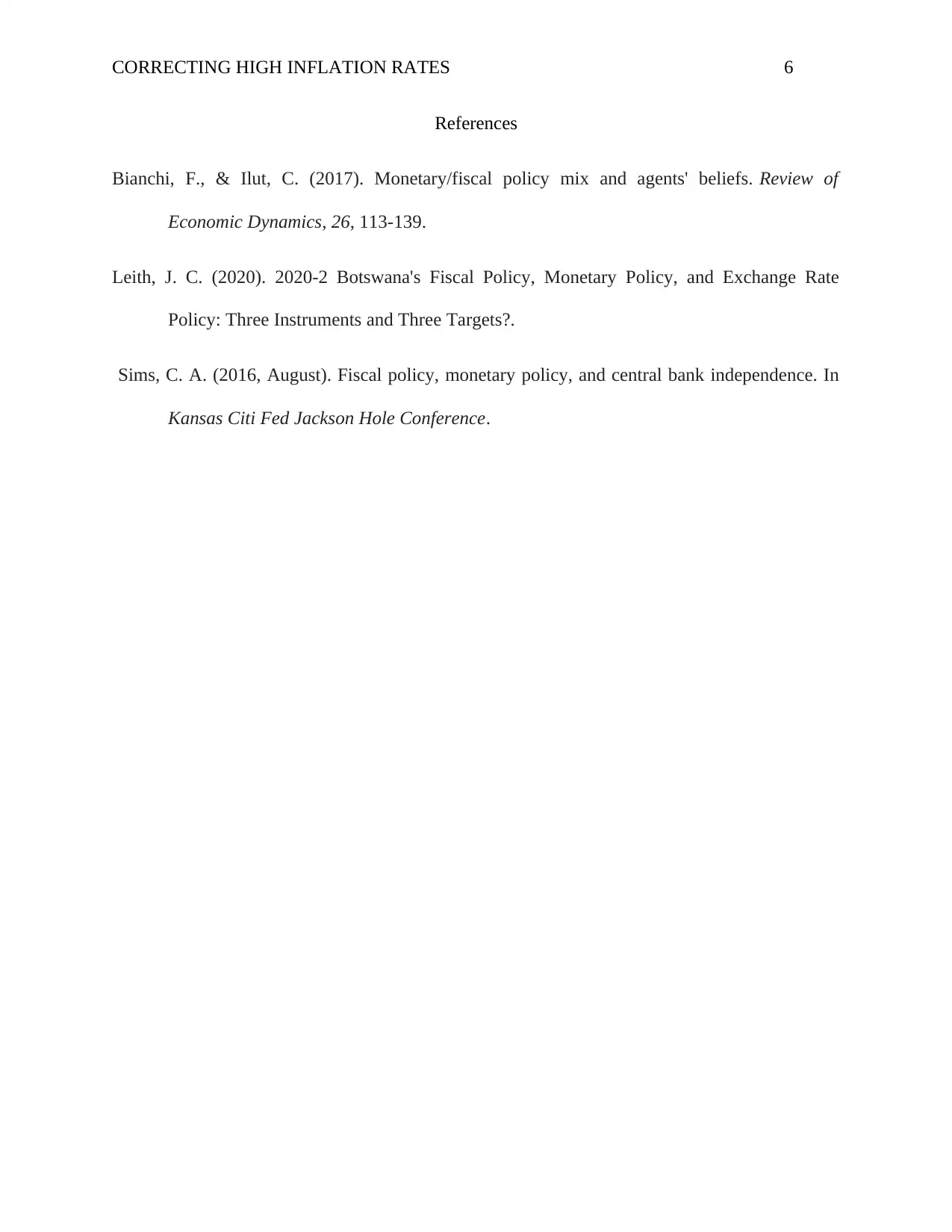
CORRECTING HIGH INFLATION RATES 6
References
Bianchi, F., & Ilut, C. (2017). Monetary/fiscal policy mix and agents' beliefs. Review of
Economic Dynamics, 26, 113-139.
Leith, J. C. (2020). 2020-2 Botswana's Fiscal Policy, Monetary Policy, and Exchange Rate
Policy: Three Instruments and Three Targets?.
Sims, C. A. (2016, August). Fiscal policy, monetary policy, and central bank independence. In
Kansas Citi Fed Jackson Hole Conference.
References
Bianchi, F., & Ilut, C. (2017). Monetary/fiscal policy mix and agents' beliefs. Review of
Economic Dynamics, 26, 113-139.
Leith, J. C. (2020). 2020-2 Botswana's Fiscal Policy, Monetary Policy, and Exchange Rate
Policy: Three Instruments and Three Targets?.
Sims, C. A. (2016, August). Fiscal policy, monetary policy, and central bank independence. In
Kansas Citi Fed Jackson Hole Conference.
⊘ This is a preview!⊘
Do you want full access?
Subscribe today to unlock all pages.

Trusted by 1+ million students worldwide
1 out of 6
Related Documents
Your All-in-One AI-Powered Toolkit for Academic Success.
+13062052269
info@desklib.com
Available 24*7 on WhatsApp / Email
![[object Object]](/_next/static/media/star-bottom.7253800d.svg)
Unlock your academic potential
Copyright © 2020–2025 A2Z Services. All Rights Reserved. Developed and managed by ZUCOL.





